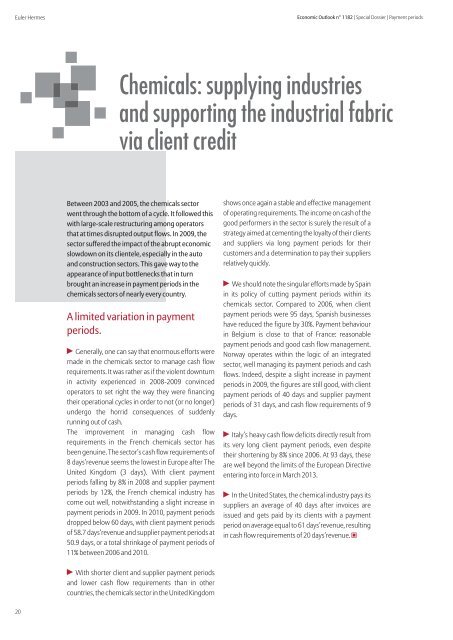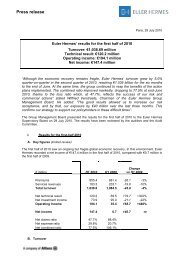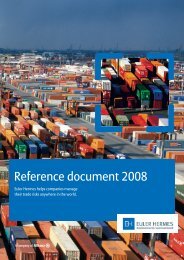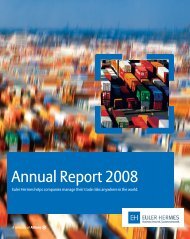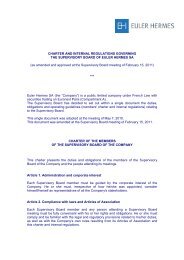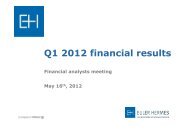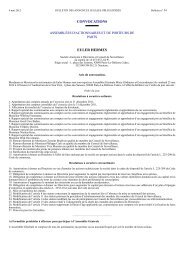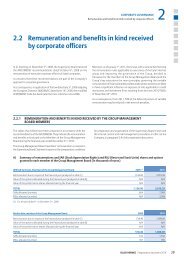Create successful ePaper yourself
Turn your PDF publications into a flip-book with our unique Google optimized e-Paper software.
<strong>Euler</strong> <strong>Hermes</strong><br />
20<br />
Economic Outlook n° 1182 | Special Dossier | <strong>Payment</strong> <strong>periods</strong><br />
Chemicals: supply<strong>in</strong>g <strong>in</strong>dustries<br />
and support<strong>in</strong>g the <strong>in</strong>dustrial fabric<br />
via client credit<br />
Between 2003 and 2005, the chemicals sector<br />
went through the bottom of a cycle. It followed this<br />
with large-scale restructur<strong>in</strong>g among operators<br />
that at times disrupted output flows. In 2009, the<br />
sector suffered the impact of the abrupt economic<br />
slowdown on its clientele, especially <strong>in</strong> the auto<br />
and construction sectors. This gave way to the<br />
appearance of <strong>in</strong>put bottlenecks that <strong>in</strong> turn<br />
brought an <strong>in</strong>crease <strong>in</strong> payment <strong>periods</strong> <strong>in</strong> the<br />
chemicals sectors of nearly every country.<br />
A limited variation <strong>in</strong> payment<br />
<strong>periods</strong>.<br />
▶ Generally, one can say that enormous efforts were<br />
made <strong>in</strong> the chemicals sector to manage cash flow<br />
requirements. It was rather as if the violent downturn<br />
<strong>in</strong> activity experienced <strong>in</strong> 2008-2009 conv<strong>in</strong>ced<br />
operators to set right the way they were f<strong>in</strong>anc<strong>in</strong>g<br />
their operational cycles <strong>in</strong> order to not (or no longer)<br />
undergo the horrid consequences of suddenly<br />
runn<strong>in</strong>g out of cash.<br />
The improvement <strong>in</strong> manag<strong>in</strong>g cash flow<br />
requirements <strong>in</strong> the French chemicals sector has<br />
been genu<strong>in</strong>e. The sector’s cash flow requirements of<br />
8 days’revenue seems the lowest <strong>in</strong> Europe after The<br />
United K<strong>in</strong>gdom (3 days). With client payment<br />
<strong>periods</strong> fall<strong>in</strong>g by 8% <strong>in</strong> 2008 and supplier payment<br />
<strong>periods</strong> by 12%, the French chemical <strong>in</strong>dustry has<br />
come out well, notwithstand<strong>in</strong>g a slight <strong>in</strong>crease <strong>in</strong><br />
payment <strong>periods</strong> <strong>in</strong> 2009. In 2010, payment <strong>periods</strong><br />
dropped below 60 days, with client payment <strong>periods</strong><br />
of 58.7 days’revenue and supplier payment <strong>periods</strong> at<br />
50.9 days, or a total shr<strong>in</strong>kage of payment <strong>periods</strong> of<br />
11% between 2006 and 2010.<br />
▶ With shorter client and supplier payment <strong>periods</strong><br />
and lower cash flow requirements than <strong>in</strong> other<br />
countries, the chemicals sector <strong>in</strong> the United K<strong>in</strong>gdom<br />
shows once aga<strong>in</strong> a stable and effective management<br />
of operat<strong>in</strong>g requirements. The <strong>in</strong>come on cash of the<br />
good performers <strong>in</strong> the sector is surely the result of a<br />
strategy aimed at cement<strong>in</strong>g the loyalty of their clients<br />
and suppliers via long payment <strong>periods</strong> for their<br />
customers and a determ<strong>in</strong>ation to pay their suppliers<br />
relatively quickly.<br />
▶ We should note the s<strong>in</strong>gular efforts made by Spa<strong>in</strong><br />
<strong>in</strong> its policy of cutt<strong>in</strong>g payment <strong>periods</strong> with<strong>in</strong> its<br />
chemicals sector. Compared to 2006, when client<br />
payment <strong>periods</strong> were 95 days, Spanish bus<strong>in</strong>esses<br />
have reduced the figure by 30%. <strong>Payment</strong> behaviour<br />
<strong>in</strong> Belgium is close to that of France: reasonable<br />
payment <strong>periods</strong> and good cash flow management.<br />
Norway operates with<strong>in</strong> the logic of an <strong>in</strong>tegrated<br />
sector, well manag<strong>in</strong>g its payment <strong>periods</strong> and cash<br />
flows. Indeed, despite a slight <strong>in</strong>crease <strong>in</strong> payment<br />
<strong>periods</strong> <strong>in</strong> 2009, the figures are still good, with client<br />
payment <strong>periods</strong> of 40 days and supplier payment<br />
<strong>periods</strong> of 31 days, and cash flow requirements of 9<br />
days.<br />
▶ Italy’s heavy cash flow deficits directly result from<br />
its very long client payment <strong>periods</strong>, even despite<br />
their shorten<strong>in</strong>g by 8% s<strong>in</strong>ce 2006. At 93 days, these<br />
are well beyond the limits of the European Directive<br />
enter<strong>in</strong>g <strong>in</strong>to force <strong>in</strong> March 2013.<br />
▶ In the United States, the chemical <strong>in</strong>dustry pays its<br />
suppliers an average of 40 days after <strong>in</strong>voices are<br />
issued and gets paid by its clients with a payment<br />
period on average equal to 61 days’revenue, result<strong>in</strong>g<br />
<strong>in</strong> cash flow requirements of 20 days’revenue. ▣


